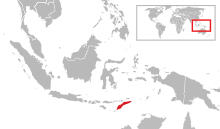Timor shrew
| Timor shrew | ||||||||||||
|---|---|---|---|---|---|---|---|---|---|---|---|---|
| Systematics | ||||||||||||
|
||||||||||||
| Scientific name | ||||||||||||
| Crocidura tenuis | ||||||||||||
| ( S. Müller , 1840) |
The Timor shrew or thin shrew ( Crocidura tenuis ) is a species of shrew that only occurs on the island of Timor . It lives in the few primary forests on the island at altitudes between 500 and 3000 meters above sea level. The destruction of their habitat is likely to threaten their existence, which is why they were listed as endangered on the IUCN's Red List of Endangered Species .
distribution
The distribution area of the Timor shrew is limited to the island of Timor , which belongs to the Lesser Sunda Islands . Here the species is common both in the Indonesian part and in East Timor . The altitude distribution extends to the highest altitudes in Timor of almost 3,000 meters. The species has only been proven at two localities, but it is assumed that it occurs more frequently, especially at high altitudes. The total range, however, probably covers less than 20,000 square kilometers, about two-thirds of the island.
Way of life
Very little data is available on the way of life of the Timor shrew. It probably lives mainly in the island's few moist primary forests at the high altitudes of the island. Their adaptability to changed habitat conditions is unknown.
Systematics
The Timor shrew is classified as an independent species within the white-toothed shrew (genus Crocidura ). The first scientific description comes from Salomon Müller in 1840. According to Jenkins (1982) it was assumed that the Timor shrew could represent a common species with the Crocidura fuliginosa , but the species status was later confirmed. However, the systematics of the white-toothed shrews with around 170 species is in constant discussion and, especially for the Southeast Asian fauna, which is characterized by many islanders, this has not yet been conclusively clarified.
Apart from the nominate form, no further subspecies are distinguished within the species .
Threat and protection
The species is classified by the International Union for Conservation of Nature and Natural Resources (IUCN) due to insufficient data on the population size, uncertain systematics and little knowledge of the way of life without classification ("data deficient"). In 1996, however, it was still considered endangered ("vulnerable").
Due to the limited knowledge of the species' ecology, actual threats to them are unknown. Since it is likely to be dependent on forest areas, the habitat changes, especially through clearing and conversion to agricultural land in the lowlands of the island, represent a potential threat to the species.
supporting documents
- ↑ a b c d e Crocidura tenuis in the endangered Red List species the IUCN 2008 Posted by: D. Lunde, K. slipway, 1996. Accessed May 22, 2013.
- ↑ a b c Crocidura tenuis ( Memento of the original dated November 11, 2013 in the Internet Archive ) Info: The archive link was inserted automatically and has not yet been checked. Please check the original and archive link according to the instructions and then remove this notice. . In: Don E. Wilson , DeeAnn M. Reeder (Eds.): Mammal Species of the World. A taxonomic and geographic Reference. 2 volumes. 3. Edition. Johns Hopkins University Press, Baltimore MD 2005, ISBN 0-8018-8221-4 .
- ↑ Masaharu Motokawa, Hon-Tsen Yu, Masashi Harada: Diversification of the white-toothed shrews of the genus Crocidura (Insectivora: Soricidae) in East and Southeast Asia. In: Mammal Study. Vol. 30, Supplement 1, 2005, ISSN 1343-4152 , pp. S53-S64, doi : 10.3106 / 1348-6160 (2005) 30 [S53: DOTWSO] 2.0.CO; 2 .
- ^ Giovanni Amori, Federica Chiozza, Carlo Rondinini, Luca Luiselli: Worldwide conservation hotspots for Soricomorpha focusing on endemic island taxa: an analysis at two taxonomic levels. In: Endangered Species Research. Vol. 15, 2011, ISSN 1863-5407 , pp. 143-149, doi : 10.3354 / esr00377 .
Web links
- Crocidura tenuis in the endangered Red List species the IUCN 2008 Posted by: D. Lunde, K. slipway, 1996. Accessed May 22, 2013.
